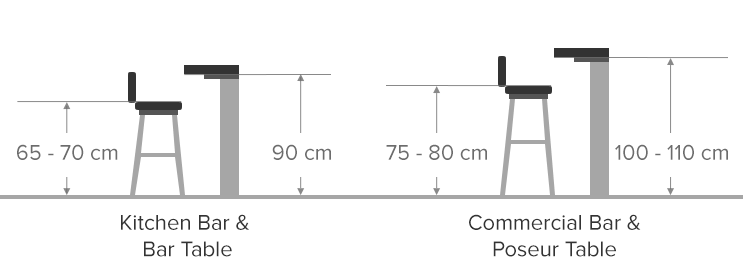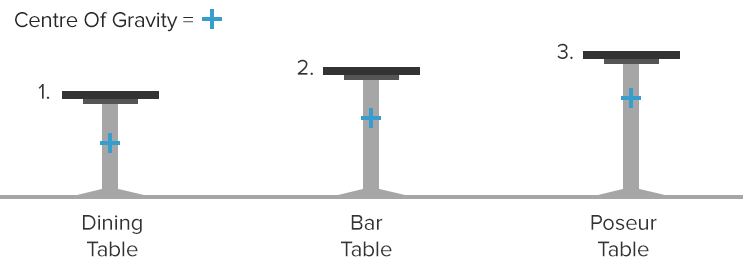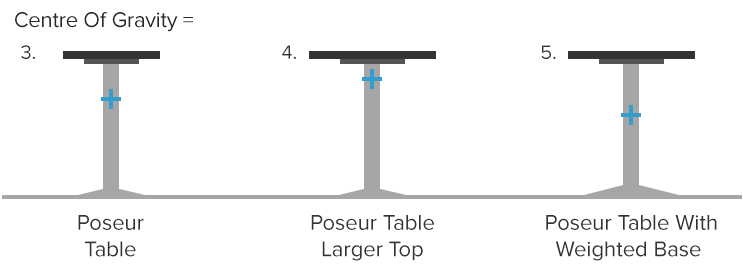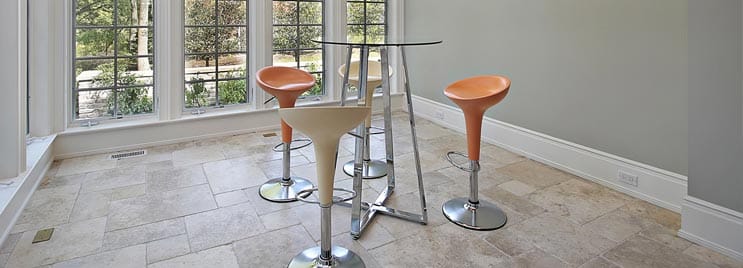
Bar Table Buying Guide
From exhibitions to kitchens, bar tables are an ever-increasing presence in homes and businesses alike. Practical and stylish, they allow you to create a compact bar area at a reasonable price. With so many bar tables to choose from, selecting the right design can be a little daunting, so we’ve produced this guide to help you to make the right choice.
The height is perhaps the most important factor to consider. Bar tables fall into one of two main categories- bar or poseur, and each is suited to a specific environment. Our standard bar tables are approximately 90cm tall, the same height as the average domestic kitchen counter. Ideal for use with any of our counter stools, they allow you to sit comfortably without your knees coming into contact with the under surface. For those seeking out commercial furniture, our poseur tables are a great choice. Generally standing at 100-110cm, these are slightly taller than standard models. Although the difference is only 10-20cm, this distinction affects the way you use them. You can stand beside them, for example in a bar or at an exhibition. They’re also great paired with taller commercial bar stools.

As a table becomes taller, the design and centre of gravity change. Taller bar and poseur models tend to have higher centres of gravity than dining tables (marked by a blue cross), and therefore are designed with larger or heavier bases to ensure that they remain perfectly stable.

As with height, the size and shape of your table will be largely determined by what you want to use it for. If you’re planning on pairing it with bar stools, then the size of the top should correspond to the number of people you need to seat around it. The average design has a top diameter of 60cm, with a base diameter of 45cm. However this can vary, so it’s worth measuring your space beforehand in order to make the best decision. The shape is also important. Round tables are more compact, and useful in high-traffic areas where angular edges are best avoided. Square tops are ideal for larger spaces, as the edges mean that they tend to occupy more room.
We also stock models with larger diameters. As shown in the diagram below, models with larger tops can have higher centres of gravity, so they’re often designed with weighted bases to keep them stable.

The top is the visual focal point of any design, and its finish plays an important role in defining the product’s overall look. Again, it’s worth considering your intended use. If you plan to serve food or drinks it’s a good idea to go for a design with a practical wipe-clean surface, like moulded ABS plastic. A durable and versatile surface, ABS can be made into a number of funky shapes and designs, plus it’s available in a wide spectrum of colours. Designs with wooden tops are also low-maintenance, and in either rich walnut or light beech, they have a natural, stylish appeal. For something a little different, faux leather lends traditional designs a modern twist, or granite and marble are classic finishes. Glass tops are also popular, as they’re easy to wipe clean, waterproof, and available in a range of styles. Whilst clear glass is beautifully minimalist, translucent, smoked, opaque and black glass offer contemporary alternatives.

The effects of the actual frame finish tend to be subtler than those of the top. The best way to select your frame finish is to consider the other items in the room. If you’ve already selected a set of shiny chrome bar stools, then a matching chrome bar table is a good choice. Or, if your kitchen contains brushed steel appliances, go for a matte brushed steel table with a similar finish for a stylish coordinated look. Both materials are substantial in weight, ensuring strength and stability, and many include rubberised plastic floor protectors to help minimise damage to floors.

Offering maximum stability, fixed height bar tables stand at bar or poseur height, with legs or a column, and a round, square or cross-shaped base to suit your taste. Other additional features range from integrated footrests to flat, heavy bases and much, much more.

Related Articles
Furniture Glossary of Terms
From ABS to 360-swivel- discover a handy glossary of the terms on our site…













